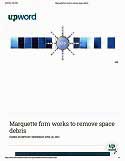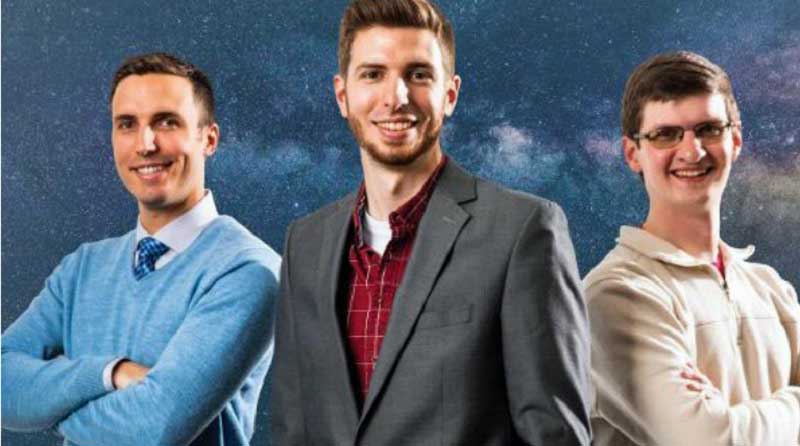Marquette firm works to remove space debris

By Dianna Stampfler
Michigan is blessed with some great stargazing locales, but how often – as you look up at the aurora borealis, Milky Way, Perseids, constellations and other celestial wonders – do you think about what else might be floating out there in space that isn’t quite so spectacular? Unfortunately, over the years the solar system has been gathering an excessive amount of debris that can cause havoc for satellites, space stations and other equipment – not to mention the fallout back to earth should a cosmic collision occur.
Friends and Northern Michigan University alumni Adam Kall and brothers, Austin and Troy Morris, had a shared interest in cleaning up space and protecting humans from the detrimental effects of orbital debris that led them form the Marquette-based Kall Morris Inc. (KMI) in 2019.
Adam, who majored in math and computer science, serves as Director of Science by driving the development of solutions and software for operations in space; Austin, who graduated with a mechanical engineering technology degree and computer numerical control certificate, is Director of Engineering and develops direct applications and solutions by building physical prototypes, products and production plans; Troy, who has a degree in psychology behavioral analysis and is KMI’s Director of Operations, runs the day-to-day operations.
“KMI currently has 10 employees, ranging from advanced theoretical science modeling and prediction to engineers focused on physical models, manufacturing, and advanced capabilities,” notes Troy. “Additionally, most of us spend a lot of time in proposal writing to various government groups (NASA, NSF, DARPA, NRO, USSF, etc.) to develop these efforts, with the fantastic support of our technical writers, project management and communications team.”
What prompted your return to Michigan to start/expand your company?
As the three co-founders met in Marquette during our undergrad at Northern Michigan University, we knew since freshman orientation that we wanted to build our lives in the UP. Seeking employment after graduation led us to major national cities (New York City, Philadelphia and Chicago), but as we became dissatisfied in those early careers, we recognized that forming our own enterprise would allow us the opportunity to return. We wanted to come back to Marquette for the quality-of-life opportunities we had in our education, and to provide high-skilled employment we didn’t have available to ourselves.
Since coming back to Marquette, we’d had the wonderful fortune of working with so many groups (including Innovate Marquette, LSCP, SBDC, MEDC, & PTAC (now APEX)) and businesses (notably Campfire Coworks, Orbion Space Technology, ATLAS Space Operations, Menlo Innovations) for meeting relevant members of the community, investments, and other ways we all work together.
In laymen’s terms, please describe your company’s goals from awareness of the issue of orbital debris to elimination/reduction of said waste.
In an oft-used terrestrial example, think of most of the space around Earth like roads. Some are busy highways (like Sun Synchronous Orbit) and have many vehicles that want to use that route (satellites for communications, Earth imaging, etc.), but these space highways have no clean-up crew or tow trucks. So, every outdated/broken down/out-of-fuel vehicle is both in the way where things might hit it and it might hit things at high speeds (orbital speeds are often 17,000 mph) causing more debris and danger.
The goal of KMI is #KeepingSpaceClearForAll, in removing the old vehicles (legacy objects) before disaster strikes. Reducing the amount of waste being produced is already happening around the world, but there’s unfortunately a critical mass already in orbit that, unless removed, could continue breaking apart and start striking current and active vehicles.
In short, we are the first tow trucks for a high-speed super highway that’s been stacking up wrecks since 1957, and we are doing it to enjoy the beauty and usefulness of space for now and the future. So, we are like park rangers, but for space (hence our Space Rangers moniker from NMU).
Can you clarify how exactly you eliminate or reduce orbital debris?
By capturing pieces of debris with a spacecraft that uses software to characterize debris, and hardware to capture debris, as seen in this video. Through this capture and deorbiting process, or moving them to a graveyard orbit which does not interfere with any other orbit, we have effectively eliminated that piece of debris. Importantly, the large pieces of debris that we are targeting have a significant risk of colliding with other debris, which would turn two pieces into many thousands of pieces. By safely eliminating the large debris before this happens, we prevent those thousands of future pieces.
How do you actually find and identify these pieces?
We utilize the services of Space Domain Awareness companies, or SDA services. The first of these is space-track.org, which is a free service provided by the 18th Space Squadron of the U.S. Military. They have been tracking debris for decades as a service to all satellite operators, but in recent years several companies have found a niche by offering more accurate and more frequent data. Some examples of these companies are LEOLabs and Privateer.
Can this debris totally be eliminated, or it is just reduced in less damaging sized pieces?
A great majority of the debris in a given orbit is in relatively few objects (think of a broken semi-truck versus broken glass on a highway). Both are dangerous, but the larger one is dangerous many more times over as it can keep creating problems unless you fully remove it at the start. It’s reasonable to say the major debris can be totally eliminated, in a relatively short amount of time as we showed in a study with MIT, and good practices will help prevent future major or minor debris. This work is led by KMI, with supporting partners at Orbion Space Technologies (Houghton, MI), ATLAS Space Operations (Traverse City, MI), Nanoracks (Houston, TX), CisLunar Industries (Denver, CO), ThinkOrbital (Lafayette, CO), and others.
At 17,000 mph almost any collision with any size object will be catastrophic for a satellite, so it is far better to keep the large pieces as a single, controlled, piece versus breaking them down into hundreds or thousands of smaller, but still deadly, debris pieces.
Where are you taking this debris and how are you physically moving it?
Initially regulators want us to deobrit the debris, which involves bringing the altitude of the object low enough that drag from the atmosphere drags it down further. This is not dangerous as we can aim for isolated parts of the ocean, specifically Point Nemo in the south Pacific Ocean. We would like to eventually bring the debris to an in-orbit station so we can save on fuel and the debris can be recycled. We move it by using Hall-Effect electric propulsion, manufactured by Orbion Space Technologies up in Houghton, Michigan.
How often does this debris make it to earth, where it causes destruction/death or does this debris more often damage valuable pieces of space equipment?
100 tons of material re-enters the Earth’s atmosphere every day; most of it over the ocean and most of it tiny pieces of space dust, asteroids, or burned up space objects. The hazard of destruction on the ground is low (10% in the next 10 years that there will be a space debris casualty on the ground), with the pressing danger being in-space destruction that 1) causes further cascading destruction like a snowstorm pileup on the highway 2) takes out critical services for emergency services, weather prediction, commerce, communication, etc. There wasn’t a single collision that prompted KMI to form, but there was the significant collision in 2009 that brought it to our attention, but collisions are happening more often, and closer to human lives like on the ISS.
Why should people care about the volume of space debris floating around?
If people like instant gratification, weather prediction, working commerce systems (from ATMs to gas pumps to mobile banking), or just not facing the world with all the technological ability of Leave It to Beaver, they should care about space debris. The volume of space debris shows the probability of catastrophic collisions, but it’s the mass of debris that shows the lethality of these collisions; and both are increasing.
KMI is working to build the future of space solutions because space is our future, in technologies and information for in space and on the ground. Humanity doesn’t reach that future without clearing the errors of the past, and then #KeepingSpaceClearForAll.
Are you the only company in the world doing orbital debris removal?
There are several companies in the world that are working on the problem, but so far none have completed an Active Debris Removal mission, with limited testing of prepared debris (brought along examples rather than actual debris).
How are businesses like yours – with an emphasis on specific environmental issues – helping change the economy of the U.P.?
The UP has always carried an interest in innovation, from pre-colonial indigenous people who carry out innovation today, to the first fur trappers and miners of early statehood, to the technology-driven innovators of today. We see that innovation in partnership with the environment, rather than at the expense of it, as a renewable economic activity that will provide stable, well-paying jobs that match the high quality of life that draws so many remote workers to the area. Focusing on fixing or maintaining the environment with these technologies is a natural outcome of eager and engaged community citizens.
Since its founding, KMI has received several awards including the Renaissance Venture Capital Winter 2021/2022 Hotlist; Center on Rural Innovation Virtual Pitch Event Winner, 2021; Michigan SBDC Best Small Business, 2022; and Space WERX Orbital Prime, 2022.
Dianna Stampfler has been writing professionally since high school. She is the president of Promote Michigan and the author of “Michigan’s Haunted Lighthouses” and “Death & Lighthouses on the Great Lakes”, both from The History Press.

